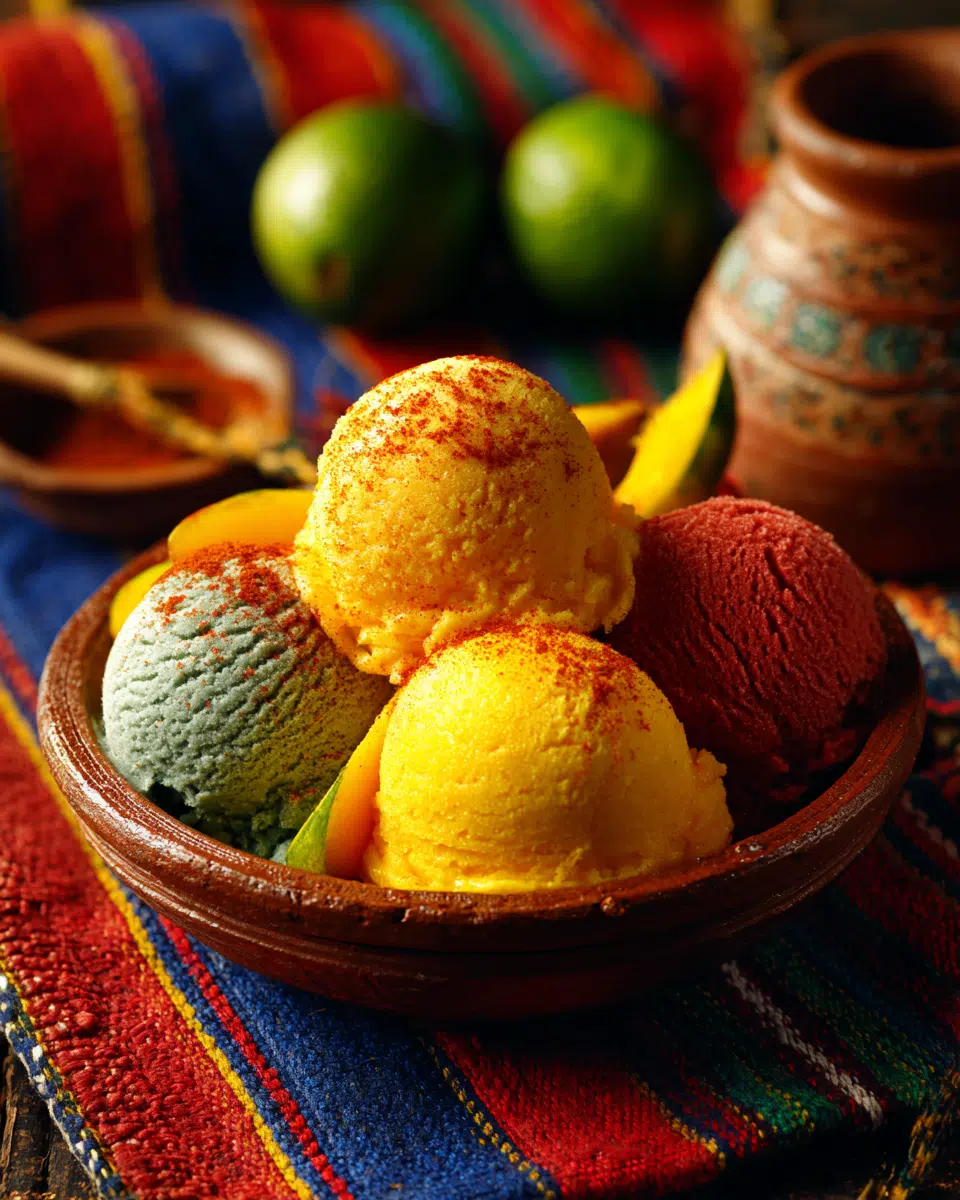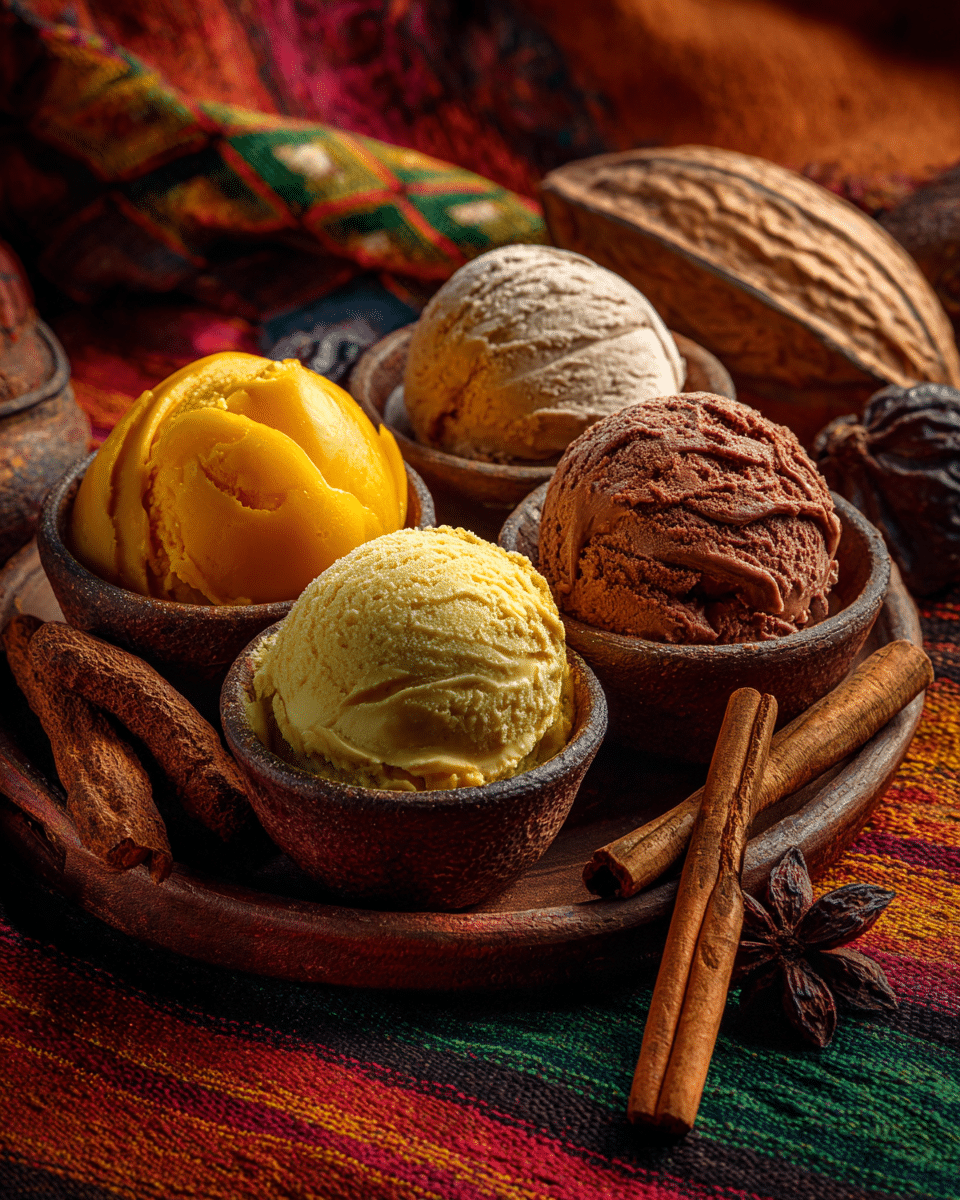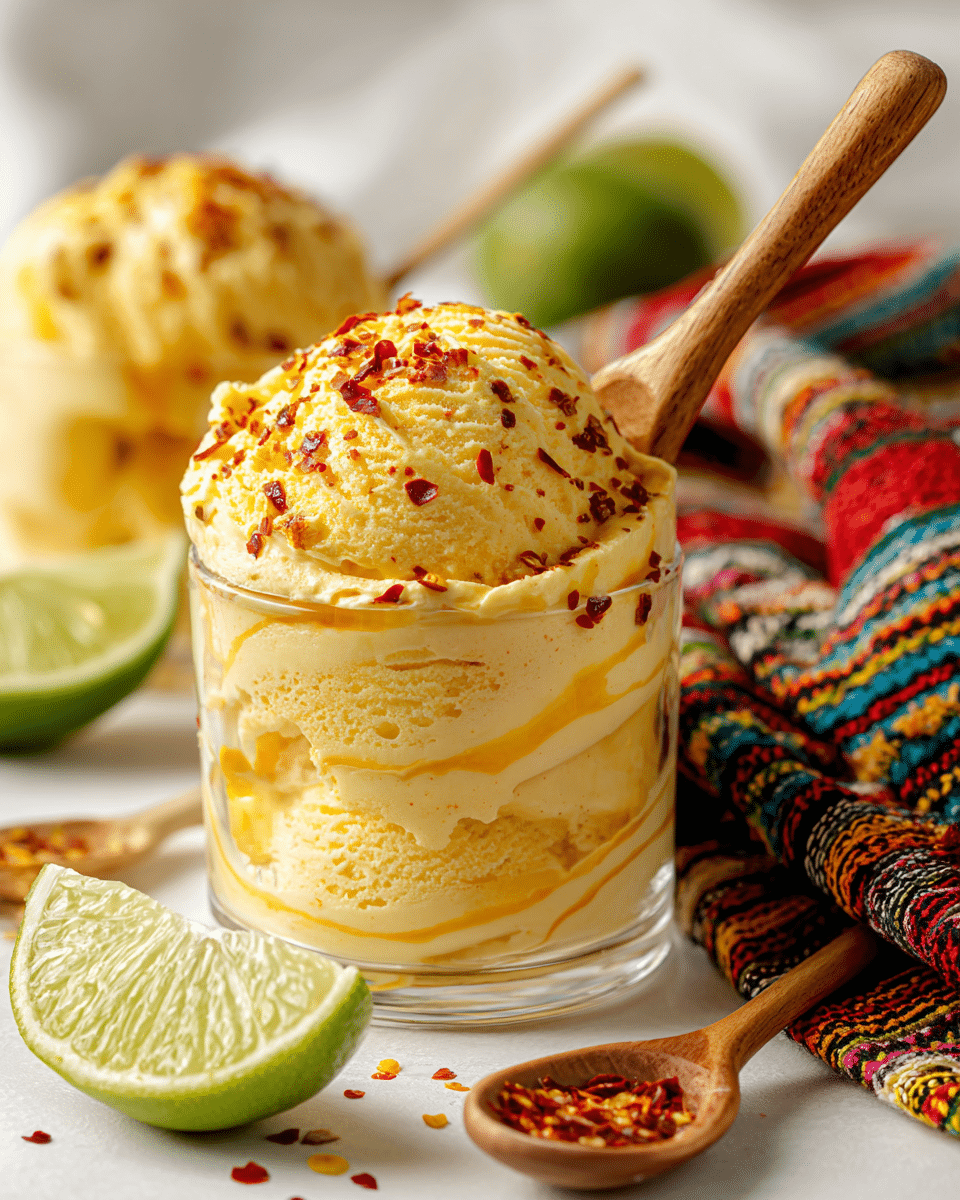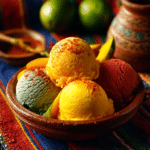

Table of Contents
Mexican ice cream isn’t just dessert—it’s a cultural journey. From the colorful streets of Oaxaca to the trendy dessert bars of Los Angeles, the unique flavors and textures of Mexican ice cream have earned global admiration. It’s creamier than gelato, fruitier than most sorbets, and deeply rooted in generations of tradition. In this article, we’ll explore everything from its origin and native ingredients to its differences from American ice cream, and why flavors like mango, tamarind, and Mexican vanilla are so unforgettable. Whether you’re curious about how to make it or want to discover the best places to find it in the U.S., we’ve got a full scoop ahead.
Learn more about authentic fruity flavors in this Mango Ice Cream Recipe.
The Origins of Mexican Ice Cream
The History Behind Mexican Ice Cream Traditions
Mexican ice cream dates back centuries—long before freezers or commercial brands ever existed. Known originally as “nieve” (Spanish for snow), it was made by blending local fruit purées with shaved ice from volcanoes and snow-capped mountains. This rustic method was popular in towns like Puebla and Michoacán, which are still renowned for their artisanal ice cream today.
During the colonial period, Spanish influence introduced dairy-based frozen desserts. However, unlike American styles that focus heavily on cream and sugar, Mexican recipes remained committed to vibrant natural flavors and native ingredients like tamarind, mamey, and prickly pear.
Street vendors called neveros or paleteros became a staple in Mexican towns, pushing colorful carts filled with handmade icy treats and bringing joy with each scoop or paleta (popsicle). This deep-rooted tradition continues across generations.
Influence of Indigenous and Spanish Flavors
Pre-Hispanic ingredients like cacao, chili, and fruits such as zapote and guava played a crucial role in shaping Mexican ice cream’s flavor palette. Indigenous Mexicans valued bold, earthy tones and natural sweeteners such as agave or piloncillo (raw cane sugar).
When the Spanish brought milk, eggs, and cinnamon to the Americas, it created a flavor fusion that still defines Mexican desserts today. For instance, you’ll often find creamy nieve de canela (cinnamon ice cream) or helado de cajeta (goat’s milk caramel) that combine both indigenous and Spanish heritage in one rich spoonful.
Even today, many ice cream makers in Mexico stick to hand-churning methods in wooden barrels packed with salt and ice—a centuries-old approach that keeps the tradition alive.
What Makes Mexican Ice Cream Different?
Traditional Ingredients That Set It Apart
Mexican ice cream isn’t just another scoop of vanilla. What sets it apart is the bold use of traditional ingredients—many of which are native to Mexico or Latin America. Instead of artificial syrups or extracts, you’ll often find:
- Real tropical fruits like mamey, guava, mango, and passionfruit
- Unique spices such as cinnamon, chili powder, and even mole
- Sweeteners like piloncillo (unrefined cane sugar) and agave nectar
- Mexican vanilla, known for its floral and woody profile
This dedication to real, fresh ingredients means each bite is bursting with authenticity. The flavors are layered, complex, and deeply satisfying—whether it’s a tart nieve de tamarindo or a creamy helado de cajeta.
Plus, many of these ice creams are made using old-world methods, often in small batches, and hand-churned in wooden barrels known as garrafas. The result? A smooth, dense treat without the fluff of mass-produced options.
Less Air, More Flavor: The Texture Difference
One of the key physical differences in Mexican ice cream lies in its low overrun—a fancy term for how much air is whipped into the mixture during churning. While commercial American ice creams can be up to 50% air, Mexican ice cream often contains much less, resulting in:
- A denser, creamier bite
- A slower melt (thanks to natural thickeners and minimal additives)
- A flavor that lingers longer on the palate
In short, you get more ice cream per spoonful—not just fluff.
In addition, many paleterías (ice cream shops specializing in paletas and nieves) pride themselves on offering small-batch, seasonal flavors that rotate weekly. That gives locals and tourists alike a reason to keep coming back to try flavors like avocado-lime, corn with cinnamon, or even tequila mango swirl.
And for those sensitive to dairy, many varieties—especially nieve—are completely dairy-free, making them a delicious and accessible option for everyone.
Looking for inspiration? Try this Almond Dacquoise Cream Clouds.


Exploring Popular Flavors of Mexican Ice Cream
Classic Favorites: Mango, Tamarind, and Vanilla
Mexican ice cream flavors are anything but basic. They reflect the country’s rich biodiversity and culinary passion. Here are a few timeless favorites that locals and tourists crave year-round:
- Mango: Creamy or icy, mango is a staple. It’s often paired with chili or chamoy for a spicy-sweet flavor explosion.
- Tamarind: This tangy, earthy fruit creates a mouth-puckering nieve de tamarindo—refreshing and unforgettable.
- Vanilla: Not just any vanilla. Mexican vanilla is world-famous for its bold, floral complexity. It tastes richer and more aromatic than typical grocery store vanilla, thanks to native Vanilla planifolia orchids grown in Veracruz.
These three flavors are so essential that you’ll find them across nearly every paletería in Mexico—and even in Mexican ice cream shops in the U.S.
Other crowd-pleasers include:
- Coconut (Coco): Rich, creamy, and sometimes studded with shredded coconut for texture.
- Strawberry (Fresa): Bursting with real fruit—never artificial coloring or syrups.
- Chocolate (Chocolate Mexicano): Often made with native cacao and a pinch of cinnamon or chili for depth.
Modern Twists with Mexican Ingredients
While the classics reign supreme, modern Mexican ice cream makers have gotten wildly creative with native flavors and textures. Here are a few you have to try:
- Mazapán: Inspired by the popular peanut candy, this ice cream is rich, nutty, and melts into a silky cream.
- Cajeta: A slow-cooked goat milk caramel, cajeta gives a luxurious, toffee-like flavor.
- Tequila or Mezcal: Yes, boozy ice cream is real—and delicious. You’ll often find these infused with mango or lime for extra punch.
- Avocado-Lime: Creamy, tangy, and slightly herbal—it’s a hit for adventurous palates.
These twists not only reflect a blend of old and new Mexico but also cater to a growing global fanbase looking for more than just chocolate or vanilla.
Flavor innovation is alive and thriving—and that’s part of what keeps Mexican ice cream so exciting.
Don’t miss our classic comfort dessert in this Burrata with Roasted Plums, Pistachios & Thyme.
Mexican Ice Cream vs. American Ice Cream
Texture, Preparation, and Flavor Profiles
While both are creamy frozen desserts, Mexican ice cream and American ice cream are worlds apart when it comes to taste, texture, and preparation style.
Texture & Churning Process
Mexican ice cream typically has less overrun (air) than American varieties, resulting in a denser and smoother bite. Where American brands may churn for speed and volume, traditional Mexican nieve is hand-churned slowly in wooden barrels packed with ice and salt—retaining more flavor and creaminess.
| Feature | Mexican Ice Cream | American Ice Cream |
|---|---|---|
| Overrun (air) | Low | High |
| Texture | Dense & smooth | Light & airy |
| Sugar | Often unrefined (piloncillo, agave) | Refined cane sugar or corn syrup |
| Churning | Manual (garrafa method) | Industrial, fast churn |
Flavor Profiles
American ice cream leans toward universally sweet and familiar flavors—vanilla, chocolate, cookies & cream. Mexican ice cream, however, takes bold risks:
- Spicy-sweet combos (e.g., mango with chili)
- Earthy fruits like tamarind or mamey
- Herbal infusions like cinnamon or anise
- Use of native ingredients like cactus, corn, and Mexican chocolate
It’s a flavor-first approach, with a cultural twist.
Cultural Approaches to Serving and Enjoyment
In the U.S., ice cream is often seen as a supermarket staple or fast-food treat. But in Mexico, ice cream is deeply cultural—a street food experience, a community event, or a way to celebrate a sunny afternoon in the plaza.
- Paleterías (ice cream shops) in Mexico are often small, family-run operations.
- Street vendors—neveros—hand-scoop from wooden tubs at local markets.
- Ice cream is a shared moment, not just a snack.
Meanwhile, American brands are typically pre-packaged, large-scale, and industrial. While they’re certainly convenient, they often lack the handmade charm and bold natural flavors that define Mexican ice cream.
And let’s not forget that Mexican ice cream often includes savory or spicy options, something rarely seen in American menus.


Making Mexican Ice Cream at Home
Traditional Recipes for Homemade Nieve
Craving authentic Mexican ice cream but can’t hop on a flight to Oaxaca? Good news—you can make it at home with just a few natural ingredients and a bit of patience. Whether you’re going dairy-free or ultra-creamy, here’s how to bring that traditional flavor to your kitchen.
Basic Nieve de Mango (Non-Dairy Sorbet-Style)
Ingredients:
- 3 ripe mangoes, peeled and diced
- 1 cup water
- ½ cup agave syrup or piloncillo (to taste)
- Juice of 1 lime
- Pinch of salt
Instructions:
- Blend all ingredients until smooth.
- Pour mixture into a shallow pan and freeze for 1 hour.
- Stir with a fork to break up ice crystals, then repeat every 30 minutes until you get a slushy texture (about 3–4 hours).
- Scoop and serve with a sprinkle of chili powder or chamoy if desired.
This method mimics the traditional hand-scraped nieves sold by street vendors, with no fancy equipment needed.
Tools, Ingredients, and Tips for Authentic Flavor
Want a creamier option? Let’s upgrade to Helado de Vainilla con Canela (Vanilla Ice Cream with Cinnamon).
Key Ingredients for Authentic Flavor:
- Mexican vanilla extract (or beans from Veracruz)
- Cinnamon sticks (not ground cinnamon—always go whole)
- Evaporated or whole milk instead of cream
- Egg yolks for a custard base
Tools You’ll Need:
- Ice cream maker (optional but helpful for texture)
- Saucepan (for heating and steeping flavors)
- Fine mesh strainer (for smoother consistency)
Tips for Authentic Results:
- Always infuse the milk with cinnamon sticks, then cool it before combining with vanilla.
- If making a custard base, cook low and slow—never boil.
- Let your base chill overnight before churning for maximum flavor.
- Use piloncillo or agave instead of white sugar for that authentic, earthy sweetness.
Once churned, let the ice cream firm up in the freezer for 2–3 hours before scooping. Serve with a sprinkle of cinnamon or a drizzle of cajeta for that perfect final touch.
This homemade process celebrates everything Mexican ice cream stands for: slow-made, full of flavor, and rooted in tradition.
What is Mexican ice cream called?
Mexican ice cream is commonly referred to as “nieve” (which means “snow” in Spanish) or “helado.”
Nieve is usually a water-based, dairy-free frozen treat, similar to sorbet, often made with fresh fruits and sweetened with agave or piloncillo.
Helado is cream-based and more similar to traditional ice cream, but it’s typically churned slower and contains less air, making it denser and more flavorful.
In some regions like Michoacán, you’ll hear the term “nieve de garrafa,” referring to the traditional wooden barrel used to make it.
What is different about Mexican ice cream?
Mexican ice cream differs from American versions in a few key ways:
Ingredients: It uses natural flavors like tamarind, mango, and real Mexican vanilla. Sweeteners like piloncillo and agave syrup are common.
Texture: It’s less airy and more dense due to low overrun.
Preparation: Many are hand-churned in wooden barrels, maintaining a rustic, artisanal feel.
What is a Mexican ice dessert called?
Mexican frozen desserts go beyond just ice cream. Some popular types include:
Nieve: Dairy-free, fruit-based ice like sorbet.
Helado: Cream-based ice cream.
Paletas: Mexican popsicles, either fruity (paletas de agua) or creamy (paletas de leche).
Raspados: Shaved ice treats flavored with syrups, fruit purées, and sometimes spicy toppings like chamoy or tajín.
Chamoyadas: A bold mix of mango, chamoy, chili, and lime, often served frozen like a slushie.
Each has its own place in Mexican street food culture.
Is Mexican ice cream dairy-free?
Some types of Mexican ice cream are dairy-free, especially nieve and fruit-based paletas.
These use:
Water or juice bases
Natural fruit purées
Agave or cane sugar for sweetness
However, helado (cream-based ice cream) and paletas de leche do contain dairy. If you’re avoiding milk, stick with nieve or ask for dairy-free options—many shops offer them!
Conclusion
Mexican ice cream is more than a dessert—it’s a celebration of culture, history, and flavor. Whether you prefer a refreshing nieve de mango, a creamy scoop of helado de cajeta, or a spicy-sweet chamoyada, there’s something uniquely satisfying about these handcrafted frozen treats.
From the rustic methods of hand-churning in wooden barrels to bold ingredients like tamarind, Mexican vanilla, and piloncillo, every spoonful tells a story. Unlike mass-produced American versions, Mexican ice cream is grounded in tradition and shaped by regional creativity.
As its popularity continues to rise across the U.S., more people are discovering what makes it so special—real ingredients, vibrant flavors, and a deep-rooted sense of place.
Want more recipes & inspo? Follow me on Facebook and save your favorites on Pinterest!
Print
Mexican Ice Cream – A Rich Scoop into Flavors, Culture, and Traditions
- Total Time: 3 hours 30 minutes
- Yield: 4 servings
- Diet: Vegan
Description
This refreshing mango nieve captures the vibrant taste of Mexican fruit sorbet using only ripe mangoes, agave syrup, lime, and a touch of salt.
Ingredients
3 ripe mangoes (peeled and diced)
1 cup water
½ cup agave syrup (or piloncillo syrup)
Juice of 1 lime
Pinch of salt
Optional: Chili powder or chamoy for serving
Instructions
1. Blend mango, water, lime juice, and agave syrup until smooth.
2. Pour the mixture into a shallow glass or metal container.
3. Freeze for 1 hour, then stir the mixture with a fork to break up ice crystals.
4. Continue freezing and stirring every 30 minutes for 3–4 hours until slushy and scoopable.
5. Serve in cups or cones and garnish with chili powder or chamoy if desired.
Notes
Use ripe mangoes for the best flavor and sweetness.
You can substitute agave with maple syrup or honey.
Add tajín or lime zest for an extra punch.
- Prep Time: 10 minutes
- Cook Time: 0 minutes
- Category: Dessert
- Method: Freeze and Stir
- Cuisine: Mexican
